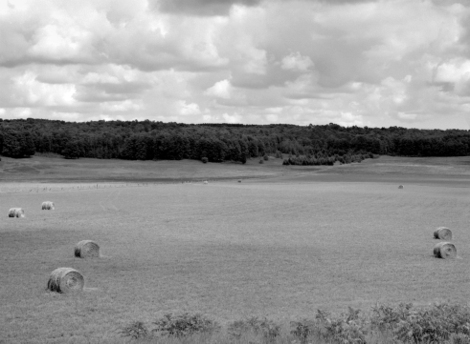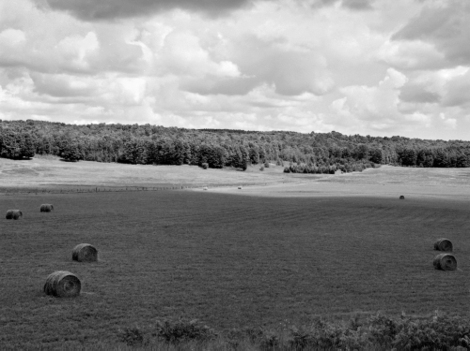Two scans from today. These are the same picture, of course. Well, two pictures taken from the same standpoint with the same framing of the same place, a hayfield in a shallow vale. If you photograph in the Great Midwest you soon learn not to demand that your landscapes be heroic. There are no towering mountains, giant waterfalls, or sweeping vistas. The landscape is much quieter, more gentle, and you have to learn to be content with that. Part of its beauty can be found in the clear air and the sweep of the clouds over the land, and the way the light and shadows bring a change of scene. The light makes all the difference. I don't think these two pictures were taken more than five minutes apart.
There is tract housing in this place now.
_________________________
Mike





I'm really happy you started scanning some of your old negatives. I admit I didn't follow your work much (just saw sometimes some of your pictures on your blog) but I prefer these scans to everything I saw before.
Posted by: giulienk | Wednesday, 24 October 2007 at 03:53 AM
Mike,
Did you see this? http://luminous-landscape.com/essays/about-light.shtml (Insert quip about great minds thinking alike.)
Best,
Adam
Posted by: mcananeya | Wednesday, 24 October 2007 at 04:08 AM
Adam,
No I hadn't, but "there is nothing new under the sun...."
Mike J.
Posted by: Mike | Wednesday, 24 October 2007 at 04:13 AM
There is at least one photographer from the heartland (Kansas) whose landscape work is quite extraordinary. See www.alexhawleyphoto.com.
Unfortunately, his classic view of fields with rolled up hay seems to be missing from his website.
Posted by: Bill Mitchell | Wednesday, 24 October 2007 at 09:01 AM
Wow, I love this. Two days in a row flogging the mule. Looking at the two shots on my monitor, the top looks a tad flat and dreary and the bottom contrasty to no good effect. The hay bales don't seem to emerge and the tree line looks a bit harsh. Going back to the upper, I wonder if with a bit of work some luminance can be developed.A bit of natural glow in the foreground and some richness in the trees. Some real work in the darkroom, and simple in PS? Tones yes, but luminance?
Just thinking out loud. $.02.
Posted by: Karl Knize | Wednesday, 24 October 2007 at 01:33 PM
Wisconsinites may not include North Dakota under the term "Great Midwest", but it's close. Well, OK, if you fudge on either or both words. If you're kind.
Hey, I've even been to Minnesota once or twice, and my sister lived in Madison for awhile.
Anyway, for drama, either wait for winter or look up. I have a favorite panoramic photo deliberately shot and stitched together on entering the North Dakota Badlands in August 2005. The word is "thunderstorms" guys. This thing filled half the sky. And had an attitude.
A lot of its attitude even bounced when it hit the ground.
North Dakota, where the weather can kill you. But it shore can be purdy. For photo see http://807north4th.com/ex/ix
Which reminded me of a guy who used to do what I remember as watercolors, though they may have been crayon. I met him about 1976. He had grain elevators floating away into the sky, or they would have except for tethers tied to heavy wooden stakes.
He also liked power line insulators. One of my favorites was "Insulators on Parade." That's all I remember except that his work was both witty and well done. And he used the word "kilozots" in some of his works. That's art in my book.
His name was Les Skoropat, and it looks like he's now the art director of Prairie Public Broadcasting in Fargo and has his own design company. But no insulator art available online. Though his web site has some photos of what looks like Fargo, if you like that sort of thing. Except for at least one shot from Bismarck. http://photo.skoropat.com/
Somehow I don't often miss the icy sidewalks or breath fog on my lens. Or being able to identify outlanders because they spelled Bismarck without the "c". Now I do it too, sometimes. But the air there is as clean as interstellar space.
Posted by: Dave Sailer | Wednesday, 24 October 2007 at 02:43 PM
Karl -- I'd consider clicking on the images, rather than critiquing the ones Typepad has resized using whatever crummy automated method it uses. You may change your tune re: the flatness.
And I know us digital types are generally supposed to like our whites white and our blacks black. but I spent four years of college at the University of Binghamton in what's known as the armpit of New York State. There, he skies are cloudy and the atmosphere bleak 205 days out of the year. It's not an uplifting place, but it does educate one on the joys of subtlety.
I'm willing to accept very, very dark grey and a very, very light grey if that's what Mike saw.
Posted by: dasmb | Wednesday, 24 October 2007 at 02:55 PM
It is amazing how simple photographs evoke a memory in the shooter's mind. This memory is well worth preserving since it recalls ghosts of life that had (or has) some significance.
I wonder if such simple images actually evokes similar (parallel, complimentary, etc) feelings to other viewers? Are such shots "universal" or are they simply a personal souvenir of the shooter?
Posted by: Tony Field | Thursday, 25 October 2007 at 12:04 AM
Tony- Some "simple" "universals" that I suspect the photographer is quite fond of:
http://www.chuckkimmerle.com/index.htm
Posted by: Greg | Friday, 26 October 2007 at 08:25 AM